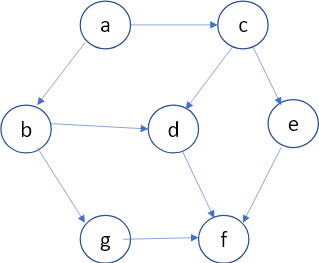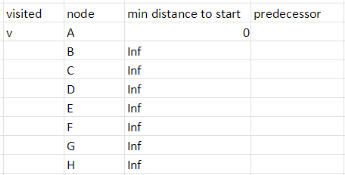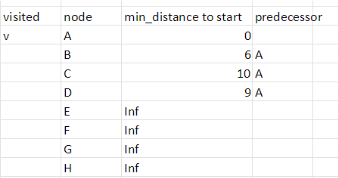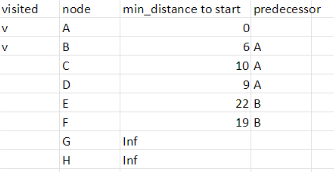單源對短路徑問題(single source shortest path problem, sssp)為給一個vertex(called source),找到去圖上其他節點的最短距離,其有三種解法 1. Breadth First Search (BFS) 2. Dijkstra’s Algorithm 3. Bellman Ford。(Depth First Search(DFS)無法解SSSP,因其一開始就走遠了......)。但BFS無法用來解有權重的圖(weighted graph),這時,我們會使用Dijskstra’s algorithm。
首先我們先來看用BFS解SSSP問題,下面範例可以搭配圖一起看:
圖1,譬如說在下面的例子中我們想看a->e的最短路徑,那麼做法就是先走一步,可以是a->c,或是a->b,b和c都不是終點,所以再走一步,可以是a->b->g, a->b->d,a->c->d, a->c->e,而e為終點,回傳a->c->e程式碼結束。Done!
from collections import deque, defaultdict
class Graph:
def __init__(self, input=None):
if input == None:
self.gdict = defaultdict(list)
else:
self.gdict = input
def __str__(self):
res = ''
for key, value in self.gdict.items():
res += f'{key}:{value}\n'
return res
# time complexity: O(E), space complexity: O(E)
# 這裡其實就是用breadth first search 的方式,一層一層的走出來,先到終點的那條路即是最短路徑
def BFS_SSSP(self, start, end):
queuepath = deque()
queuepath.append([start])
while len(queuepath) != 0:
path = queuepath.popleft()
node = path[-1]
if node == end:
return path
for i in self.gdict.get(node, []):
new_path = list(path)
new_path.append(i)
queuepath.append(new_path)
customDict = {'a': ['b', 'c'], 'b': ['d', 'g'], 'c': ['d', 'e'], 'd': ['f'], 'e': ['f'], 'g': ['f']}
mygraph = Graph(customDict)
print(mygraph.BFS_SSSP('a', 'e'))
>> ['a', 'c', 'e']
## 這裡我們得出a到e的最短路徑為a -> c -> e
猶如我們前面提到BFS無法用在weighted graph上,接著我們來介紹Dijkstra's algorithm。Dijkstra's algorithm也是用來解決單源路徑問題,它weighted graph和unweighted graph都可以解決,它的計算算是一種貪婪算法(greedy algorithm),從下面的程式碼/圖我們可以發現,我們不斷為每個點找局部最小值(局部最佳解),並標註為visited,一直到所有節點都被標註完。一般來說貪婪算法找到的局部最佳解未必是全域最佳解,但在使用Dijkstra's algorithm上的限制:邊(edge)的權重(weight)不能為負,使找出來的局部最佳解可以為全域最佳解,我們直接用圖和表格來說明可能更好理解:
圖2 今天我們有個directed weight graph,我們想從A出發,然後找到到各點的最短距離
那我們可以follow 以下表格,首先創建一個表格,有選項visited、node(節點)、到初始點最小距離、predecessor(前一個節點)
Step 0 由A開始,設其餘到A點距離無限大(Inf),A自己到自己0,A為最小值,標記為visited
step 1 A可以到B,D,C:0+edge分別為6,9,10,皆小於Inf,更新表格並填A為他們的前一個節點。此時B為為標記的點裡最小,標記B為visited。
Step 2 B點可以到D, E, F。D: 6+5=11>9 不用更新,E:6+16=22小於Inf 更新,F:6+13=19小於Inf更新。同樣的方式以此類推......
Step 3 細節參考表格右邊小小的計算
Step 4
Step 5
Step 6
Step 7
所以如果我們想知道起始點A到某一點的最短路徑,我們可以從predecessor推回去,舉例來說,如果我們想找A到H最短路徑: H<-C<-A, 根據表格最短路徑就會是15,以此類推。接著我們來看程式碼:
import heapq
class Edge:
def __init__(self, v1, v2, w):
self.weight = w
self.start_vertex = v1
self.target_vertex = v2
# 這裡我們預設所有min_distance無限大,之後再來更新
# 然後用neightbors來append edge
class Node:
def __init__(self, v1):
self.name = v1
self.neighbors = []
self.min_distance = float('Inf')
self.visited = False
self.predecessor = None
# 這個是python class內建<符號對應的function,那這裡我們是要讓不同節點間的min_distance去做比較
def __lt__(self, other):
return self.min_distance < other.min_distance
def add_edge(self, w, v2):
new_edge = Edge(self, v2, w)
self.neighbors.append(new_edge)
# 這裡計算的概念跟我們文章前面講的一樣,這裡就不再贅述,大家可以自己看一遍後實作一遍
class Dijkstra:
def __init__(self, start=None):
self.heap = []
self.start = start
def calculate(self, start):
self.start = start
start.min_distance = 0
heapq.heappush(self.heap, start)
while self.heap:
current_vertex = heapq.heappop(self.heap)
if current_vertex.visited:
continue
for edge in current_vertex.neighbors:
start_vertex = edge.start_vertex
target_vertex = edge.target_vertex
new_distance = current_vertex.min_distance+edge.weight
if new_distance < target_vertex.min_distance:
target_vertex.min_distance = new_distance
target_vertex.predecessor = start_vertex
heapq.heappush(self.heap, target_vertex)
current_vertex.visited = True
def find_shortest_path(self, end):
print(
f'The shortest path from {self.start.name} to {end.name} is {end.min_distance}')
route = []
current = end
while current:
route.append(current.name)
current = current.predecessor
route.reverse()
print('->'.join(route))
nodeA = Node('A')
nodeB = Node('B')
nodeC = Node('C')
nodeD = Node('D')
nodeE = Node('E')
nodeF = Node('F')
nodeG = Node('G')
nodeH = Node('H')
nodeA.add_edge(6, nodeB)
nodeA.add_edge(10, nodeC)
nodeA.add_edge(9, nodeD)
nodeB.add_edge(16, nodeE)
nodeB.add_edge(5, nodeD)
nodeB.add_edge(13, nodeF)
nodeC.add_edge(6, nodeD)
nodeC.add_edge(5, nodeH)
nodeC.add_edge(21, nodeG)
nodeD.add_edge(8, nodeF)
nodeD.add_edge(7, nodeH)
nodeE.add_edge(10, nodeG)
nodeF.add_edge(12, nodeG)
nodeF.add_edge(4, nodeE)
nodeH.add_edge(2, nodeF)
example = Dijkstra()
example.calculate(nodeA)
example.find_shortest_path(nodeE)
>> The shortest path from A to E is 21
A->D->F->E
我們前面提到,當權重(weight)為負的時,我們無法使用Dijkstra's algorithm,於是接下來我們要介紹Bellman- Ford algorithm,我感覺把這個放在這篇講感覺會比較連貫。Bellman-Ford Algorithm也是用來解決單源最短路徑問題,其也是可以用在weighted和unweighted graphs. 它可以解決Dijkstra’s algorithm 解決不了的negative edge weights graph(圖裡有邊的權重為負的)。但其仍無法解決有負循環途徑(negative cycle)的圖(也就是圖裡有一個cycle(循環途徑),其權重總和為負值),因為如果我們重複無限次的去走這個負循環途徑,算出來的值可以持續無限制的降低。雖然Bellman-Ford無法計算有負循環途徑的圖,但Bellman-Ford能夠判斷圖裡是否有負循環途徑。
那判斷的方法如下,假設我們在圖中有N個節點,那麼要算得單源最短路徑,總共最多N-1次的更新最短路徑。(N-1的原因是,如果我們有N個節點,我們最多就只N-1個邊(edges),讓每個邊都走過一遍)。如果我們走第N次,最短路徑(shortest distance)還在被更新,那麼我們說這個graph裡面有negative cycle。以下我們看程式碼比較快,我覺得Bellman-Ford比Dijkstra 來得好理解:
class Graph:
# 初始化graph,NumV:vertice的數目
def __init__(self):
self.NumV = 0
self.graph = []
self.node = []
# 增加節點
def add_node(self, vertice):
self.node.append(vertice)
self.NumV += 1
# 增加邊
def add_edge(self, start, target, weight):
self.graph.append([start, target, weight])
# bellmanford algorithm: 我們選起始點
def bellmanford(self, source):
# 創建distance字典
# 一開始我們設所有結點的min distance為Inf
mydict = {i: float('Inf') for i in self.node}
# 起始點min distance為0
mydict[source] = 0
# 我們需要更新比較n-1次
for _ in range(self.NumV-1):
for start, target, weight in self.graph:
if mydict[start] != 'Inf' and mydict[start]+weight < mydict[target]:
mydict[target] = mydict[start]+weight
# 如果過了n-1次 它還在更新,那麼圖裡肯定有negative cycle
if mydict[start] != 'Inf' and mydict[start]+weight < mydict[target]:
return 'The graph contains a negative cycle'
else:
res = ''
for key, value in mydict.items():
res += f'{key}:{value}\n'
return res
g = Graph()
g.add_node('A')
g.add_node('B')
g.add_node('C')
g.add_node('D')
g.add_node('E')
g.add_edge('A', 'C', 6)
g.add_edge('A', 'D', 6)
g.add_edge('B', 'A', 3)
g.add_edge('C', 'D', -1)
g.add_edge('D', 'C', 2)
g.add_edge('D', 'B', 1)
g.add_edge('E', 'B', 4)
g.add_edge('D', 'E', 2)
print(g.bellmanford('A'))
>> A:0
B:6
C:6
D:5
E:7
# 得到從A點出發到各點的最短距離!
參考資料:
The Complete Data Structures and Algorithms Course in Python (Udemy)
https://www.geeksforgeeks.org/bellman-ford-algorithm-dp-23/

 iThome鐵人賽
iThome鐵人賽
 看影片追技術
看更多
看影片追技術
看更多